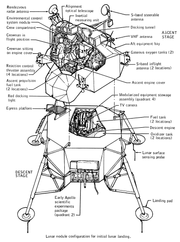
Back Apollo-maanmodule AF Apollo Lunar Module AN وحدة أبولو القمرية Arabic Apollon ay modulu AZ آپولو آیدا اوتورانی AZB Лунен модул Bulgarian অ্যাপোলো লুনার মডিউল Bengali/Bangla Modul-loar Apollo BR Mòdul lunar Apollo Catalan مانگنشینی ئەپۆڵۆ CKB
 Apollo 14 Lunar Module Antares on the Moon's surface, February 1971 | |
| Manufacturer | Grumman |
|---|---|
| Designer | Thomas J. Kelly |
| Country of origin | United States |
| Operator | NASA |
| Applications | Crewed lunar landing |
| Specifications | |
| Spacecraft type | Lunar lander |
| Launch mass |
|
| Dry mass |
|
| Crew capacity | 2 |
| Volume | 235 cu ft (6.7 m3) |
| Power | 28 V DC, 115 V 400 Hz AC |
| Batteries | Six or seven 28–32-volt, 296 ampere hour silver-zinc |
| Regime | |
| Design life | 75 hours (extended) |
| Dimensions | |
| Length | 23 ft 1 in (7.04 m) |
| Diameter | 13 ft 10 in (4.22 m) without landing gear |
| Width | 31 ft (9.4 m), landing gear deployed |
| Production | |
| Status | Retired |
| Built | 15 |
| Launched | 10 |
| Operational | 10 |
| Retired | 1972 |
| Failed | 0 |
| Lost | 0 |
| Maiden launch | January 22, 1968 |
| Last launch | December 7, 1972 |
| Last retirement | December 14, 1972 |
| Related spacecraft | |
| Flown with | Apollo Command and Service Module |
| Configuration | |
 | |
The Apollo Lunar Module (LM /ˈlɛm/), originally designated the Lunar Excursion Module (LEM), was the lunar lander spacecraft that was flown between lunar orbit and the Moon's surface during the United States' Apollo program. It was the first crewed spacecraft to operate exclusively in the airless vacuum of space, and remains the only crewed vehicle to land anywhere beyond Earth.
Structurally and aerodynamically incapable of flight through Earth's atmosphere, the two-stage Lunar Module was ferried to lunar orbit attached to the Apollo command and service module (CSM), about twice its mass. Its crew of two flew the Lunar Module from lunar orbit to the Moon's surface. During takeoff, the spent descent stage was used as a launch pad for the ascent stage which then flew back to the command module, after which it was also discarded.
Overseen by Grumman, the LM's development was plagued with problems that delayed its first uncrewed flight by about ten months and its first crewed flight by about three months. Regardless, the LM became the most reliable component of the Apollo–Saturn space vehicle.[1] The total cost of the LM for development and the units produced was $21.65 billion in 2016 dollars, adjusting from a nominal total of $2.29 billion[2] using the NASA New Start Inflation Indices.[3]
Ten Lunar Modules were launched into space. Of these, six were landed by humans on the Moon from 1969 to 1972. The first two flown were tests in low Earth orbit: Apollo 5, without a crew; and Apollo 9 with a crew. A third test flight in low lunar orbit was Apollo 10, a dress rehearsal for the first landing, conducted on Apollo 11. The Apollo 13 Lunar Module functioned as a lifeboat to provide life support and propulsion to keep the crew alive for the trip home, when their CSM was disabled by an oxygen tank explosion en route to the Moon.
The six landed descent stages remain at their landing sites; their corresponding ascent stages crashed into the Moon following use. One ascent stage (Apollo 10's Snoopy) was discarded in a heliocentric orbit after its descent stage was discarded in lunar orbit.[4] The other three LMs were destroyed during controlled re-entry in the Earth's atmosphere: the four stages of Apollo 5 and Apollo 9 each re-entered separately, while Apollo 13's Aquarius re-entered as a unit.
- ^ Moon Race: The History of Apollo DVD, Columbia River Entertainment (Portland, Oregon, 2007)
- ^ Orloff, Richard (1996). Apollo by the Numbers (PDF). National Aeronautics and Space Administration. p. 22. Archived (PDF) from the original on February 22, 2016. Retrieved May 23, 2016.
- ^ "NASA New Start Inflation Indices". National Aeronautics and Space Administration. Archived from the original on June 24, 2016. Retrieved May 23, 2016.
- ^ Dickinson, David (June 14, 2019). "ASTRONOMERS MIGHT HAVE FOUND APOLLO 10'S "SNOOPY" MODULE".